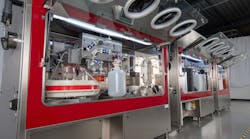It’s no secret that embracing the digital transformation requires an investment in the right software tools and platforms. But it’s also critical that the right workforce is in place to usher in the changes.
In fact, building a “workforce of the future” is one of the most pressing issues emerging from the IT world, according to Michele D’Alessandro, vice president and chief information officer of manufacturing IT at Merck & Co.
During a recent presentation on innovative manufacturing strategies at the PDA Annual Meeting in Orlando, D’Alessandro said that despite all of the advancements Merck has made in constructing smart manufacturing facilities, those achievements could be in jeopardy if the company doesn’t factor in the human side of the equation.
“At Merck, approx. 30 percent of our workforce are retirement eligible,” she said. “If they leave before we have new people in place, with the requisite knowledge transfer, we will not be able to compete as well going forward.”
In short, she advised that companies, “build a workforce for the future and build it now.”
Here are D’Alessandro’s key strategic considerations when shaping an employee base that will keep the company on pace with digital transformations.
Leverage the advantages of incoming generations: The new generation has grown up with digital tools at their fingertips. Naturally, that gives them a leg up when it comes to dreaming up new digital solutions. But there’s no substitute for institutional knowledge, which is also critical for making informed decisions. To get the best of both worlds, build strong working partnerships between experienced employees and newcomers to leverage both ways of approaching problems.
Stay agile: The rate of change is still increasing at an increasing rate. Building a forward-thinking workforce will help the company stay nimble and able to adapt.
Consider the entire eco-system of potential employees: The right workforce doesn’t just have to be full-time employees. In addition to looking a traditional workforce, try creating partnerships with academia to have access to student and new research, or collaborating with other companies and pool your combined talent.
Avoid layoffs by re-tooling employees: Even if certain technologies become obsolete, the talent that drove those innovations doesn’t have to be let go. Instead of layoffs, think of ways to retool employees into new positions with the latest tech.
According to D’Alessandro, “I-sourcing” (the inverse of outsourcing) has become a key goal at Merck and is one of the driving factors behind the push to create the most optimal workforce.
“We learned a lot from the heyday of outsourcing, and that we went too far with certain skills,” D’Alessandro notes, saying that the shift in the company’s mindset is part of what she believes will drive its success in the future.



